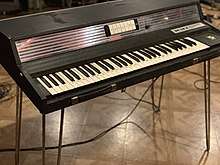Rocky Mount Instruments
Rocky Mount Instruments or RMI was a subsidiary of the Allen Organ Company, established in about 1966.[1] It was based in Rocky Mount, North Carolina.[2] It is most famous for the RMI Electra Piano, a keyboard instrument that created piano and harpsichord-like sounds without the use of strings, tines, or reeds, instead using transistors, much like the combo organs of the day.

Combo organs
In fact, the first models produced were combo organs, including the four-octave "Explorer" (using a dedicated oscillator for each key), the "Lark", the "Band Organ" (a three-octave electrical imitation of a calliope) and the "Calliope" and "Calliope B" around 1968 or early 1969. The first electric piano model was the "Model 100 Rock-Si-Chord" in 1967.[1] Retailing for $4,695,[3] it contained only 2 sounds (string and lute) but was later updated as the "Model 100A" which contained 5 sounds (harpsichord, cembalo, lute, Guitar A, and Guitar B). The "Model 200 Rock-Si-Chord" produced in 1968 was similar the first "Model 100", but featured an accenter option that shortened the decay of the sound. The "Model 200A" however featured twice as many sounds as the "Model 100A".
Electra-pianos
Beginning in 1967, RMI began producing the 300 Series Electra-piano, the sound of which became very familiar to fans of bands such as Genesis (who used the instrument extensively from 1974 to 1977), Yes and Deep Purple. On Miles Davis 1968 album Filles de Kilimanjaro a RMI electra-piano is played by Chick Corea.
The original 300A and B models had 61 keys. Eventually seven more keys were added to create the 368 model (but not touch-sensitivity).

The 368x was essentially a 368 housed in a new molded plastic case instead of the previously used vinyl covered plywood. In 1973, RMI came out with the Model 400 which was a 300 with a self-contained sound system aimed more at the home-user market, and the 600 series, which was a stereo version of the 300 with two tone generators per key, but also included some newer sounds.
Other products
In 1974, RMI produced the pioneering "Keyboard Computer" model keyboard instrument, the first portable digital sample player. It produced sounds from waveform model punch cards which were input and digitized into volatile memory, and used no magnetic tapes (in contrast to how Mellotron, Chamberlin, and Birotron created their sounds).
From 1974-76 RMI produced its only true synthesizer, the $3,000 RMI Harmonic Synthesizer,[4] an instrument that was years ahead of its time (Yamaha's DX-7 was released in 1983, nine years later) but not widely used or understood. The 48-key dual mono, analog/digital hybrid synth featured two digital harmonic generators (16 harmonics each, with two sets of harmonic sliders), five presets, an LFO, arpeggiator, a VCF with mixable low-pass, band-pass and high-pass outputs,[5] and AM and FM capability.[4][6] It was used most prominently by Jean Michel Jarre who played the RMI Harmonic Synthesizer on his Oxygène (1976) album as well as on many other albums that were to follow later. Stevie Wonder and Isaac Hayes were also rumoured to have this instrument in their rigs. In more recent times, the Harmonic Synthesizer was used by Richard D. James aka Aphex Twin and Stephen Parsick/['ramp].
In 1979 RMI introduced the DK-20 (Digital Keyboard) as a replacement for the old analog 300 Series. This model was produced until 1982.
Notable users
RMI 368 Electra-piano - Jon Lord in Deep Purple, Rick Wakeman with Yes, and in his solo albums, Tony Banks with Genesis, Bernie Worrell with Funkadelic, Edgar Winter (Entrance, 1970), Steve Winwood in the Traffic album John Barleycorn Must Die (1970).
RMI Keyboard Computer - Rick Wakeman in Yes albums Going for the One (1977) and Tormato (1978). Billy Beck, Ohio Players
End, Legacy
The company ceased to exist by 1982.[1]
References
- Reid, Gordon. "PROG SPAWN! The Rise And Fall Of Rocky Mount Instruments". Sound On Sound Ltd. Archived from the original on 25 December 2011. Retrieved 5 July 2010.
- Emerick, Tom. "Rocky Mount Instruments (RMI)". Synthmuseum.com. Retrieved 5 July 2010.
- Emerick, Tom. "RMI Model 100 Rock-Si-Chord". Synthmuseum.com. Retrieved 5 July 2010.
- Emerick, Tom. "RMI Harmonic Synthesizer". Synthmuseum. Retrieved 6 July 2010.
- RMI advert image at Synthmuseum
- Vinceblood and Jarreweb. "RMI Harmonic Synthesizer". Jarrography. Retrieved 5 July 2010.